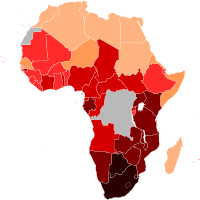
Photo from wikipedia
Cash transfers have been increasingly used in low- and middle-income countries as a poverty reduction and social protection tool. Despite their potential for empowering vulnerable groups (especially women), the evidence… Click to show full abstract
Cash transfers have been increasingly used in low- and middle-income countries as a poverty reduction and social protection tool. Despite their potential for empowering vulnerable groups (especially women), the evidence for such outcomes remains unclear. Additionally, little is known about how this broad concept fits into and is perceived in such programs. For example, Lesotho's Child Grant Program (CGP) is an unconditional cash transfer targeting poor and vulnerable households with children. The CGP has been presented as one of Lesotho's flagship programs in developing the country's social safety net system. Using the CGP's early phases as a case study, this research aims to capture how program stakeholders understood and operationalized the concept of economic empowerment (especially women's) in Lesotho's CGP. The qualitative analysis relied on the triangulation of information from a review of program documents and semi-structured key informant interviews with program stakeholders. First, the program documents were coded deductively while the interview transcripts were coded inductively, then both materials were analyzed thematically. Finally, differences or disagreements within each theme were explored individually according to the program's chronology, the stakeholders' affiliation, and their role in the CGP. The complexity of economic empowerment was reflected in the diversity of definitions found in the desk review and interviews. Economic empowerment was primarily understood as improving access to economic resources and opportunities, and less so, as agency and social and economic inclusion. There were stronger disagreements on other definitions as they seemed to be a terminology primarily used by specific stakeholders. This diversity of definitions impacted how these concepts were integrated into the program, with particular gaps between the strategic vision and operational units as well as between the role this concept was perceived to play, and the effects evaluated so far.
Journal Title: Health policy and planning
Year Published: 2023
Link to full text (if available)
Share on Social Media: Sign Up to like & get
recommendations!